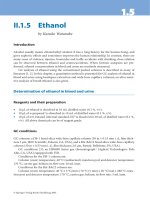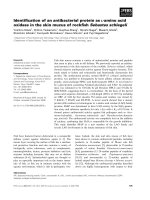Energy Storage in the Emerging Era of Smart Grids Part 14 pot
Bạn đang xem bản rút gọn của tài liệu. Xem và tải ngay bản đầy đủ của tài liệu tại đây (3.12 MB, 30 trang )
17
Practical Application of Electrical Energy
Storage System in Industry
Drabek, Streit and Blahnik
University of West Bohemia Plzen,
Faculty of Electrical Engineering,
Czech Republic
1. Introduction
1.1 Industry application of ESS
Storing of energy allows balancing of the supply and demand of energy. Today, the energy
storage system (ESS) in commercial use can be broadly categorized as mechanical, electrical,
chemical, biological and thermal. In further we will discuss electrical and partly mechanical
system. Accumulation of electrical energy presents a big problem solved by a lot
of specialists and scientists. Many ways of accumulation has been put into practice (for
example: systems using flywheel, battery, supercapacitor etc.). Today commonly used
vehicles of light traction (trams, trolleybuses) are not able to accumulate their kinetic energy.
Saving of this energy is possible only by regenerative braking. This method is possible when
another tram starts up on the same part of trolley line. Nowadays electrical energy storage
system can be found in transport vehicles and in power engineering systems. In general
the energy-storage devices charge during low power demands and discharge during high
power demands, to provide energy boost when needed.
Carbon emissions, the depletion of natural resources by fast consumption, traffic congestion
and the rising costs of fossil fuels are all issues pushing the world to search for alternative
means of transportation. Mass-transit buses, fleet vehicles, long-haul trucks and other
heavy-transportation vehicles such as trains, light rails, trams and subways, all benefit from
the using of a hybrid power drives in relation to the energy storage system. The global
number of vehicles around the World will triple in the next 50 years (Chan & Wong, 2004).
Thus, methods of improving fuel economy have gained worldwide attention. The efficiency
and all-electric range (AER) of hybrid electric vehicles (HEVs) depend on the capability
of their energy-storage system (ESS), to store large amounts of energy and release it quickly
according to load demands.
In transport ESS allows accumulation of the braking energy in conventional vehicles and
special racing vehicles such as Formula 1. The kinetic energy is accumulated into the ESS
during vehicle braking. This energy can be used to the vehicle acceleration again. It is
important to save the energy in the vehicles accelerating very often such public transport
vehicles (we can think about stabile or mobile version according to the local specific
conditions).
Heavy transportation vehicles - such as trains, trams and subways - place particular
demands on energy storage devices. Such devices must be very robust and reliable,
Energy Storage in the Emerging Era of Smart Grids
380
displaying both long operational lifetimes and low maintenance requirements. Further,
the devices must operate efficiently under harsh conditions including handling peak
currents, high duty cycles and frequent deep discharging.
ESS can absorb and store all kinetic energy from a braking system, depends on total energy
designed in ESS. The emission-free stored electrical energy in ESS is then available to assist
in acceleration, to reduce fuel consumption and accompanying emissions or energy drain, as
well as drive the air conditioner, operate power steering or perform other electrical
functions. As an added bonus, regenerative braking takes most of the mechanical brakes
load off, reducing brake maintenance and replacement expenses.
Very important area of ESS is power engineering where the ESS covers small to large rated
power range, including active PFC used to set the appropriate power factor and harmonic
emission to the power grid.
The important characteristics of ESSs include energy density, power density, lifetime, cost,
energy storage time and maintenance (see Fig. 3 and Fig. 4). Currently, batteries and
ultracapacitors are the most common options for vehicular ESSs. Batteries usually have high
energy densities and store the majority of onboard electric energy. On the other hand,
ultracaps have high power densities and present a long life cycle with high efficiency and
a fast response for charging/ discharging (Burke, 2007; Khaligh & Li, 2010; Zhang et al.,
2008; Lu et al., 2007). A fuel cell (FC) is another clean energy source (Fig. 1 and Fig. 2);
however, the long time constant of the FC limits its performance on vehicles. Very
perspective ESS shows the flywheel system with low cost benefit and high energy density.
However using flywheel in the transport is a bit disputable due to gyroscopic effect.
Nevertheless for stationary systems the ESS with flywheels presents perspective topology
with respect the low energy storage time (Fig. 4), this system cannot be used as back up
power source as batteries and ultracaps.
Fig. 1. City bus powered by Fuel Cells (TriHyBus.cz, 2008).
Fig. 2. Detail on fuel cells, the ESS is composed of Li-ion battery and supecapacitors
(TriHyBus.cz, 2008)
Practical Application of Electrical Energy Storage System in Industry
381
As design engineers have found, batteries have high-energy capability while
the ultracapacitors have high power capability. In an optimal hybrid alternative drive system,
both technologies could be combined in a way that maximizes the benefits of both. In general
vehicles have batteries to provide energy back up for control systems, start engine etc.
The ESS of most of the commercially available HEVs is composed of only battery packs with
a bidirectional converter connected to the high-voltage dc bus (the Toyota Prius, Honda
Insight, and Ford Escape).
Start-stop technology enables the engine in conventional, electric or hybrid-electric delivery
trucks and refuse vehicles to shut down when they come to a stop at a red light, picking up
or dropping off passengers, or when sitting in traffic. ESS then provides a short burst
of energy that restarts the motor. ESS can save millions of barrels of oil over conventional
gasoline-only powered vehicles.
Fig. 3. Comparison of several ESS due to energy and power density
Fig. 4. Comparison of Energy storage time of several ESS
2. Battery
Batteries have widely been adopted in ground vehicles due to their characteristics in terms
of high energy density, compact size, and reliability (Lukic et al, 2008).
The Batteries have a very wide field of applications in systems for the electrical ESS. They
are used in stationary systems, as short time power sources (eg UPS).The other applications
are in transport, used as the main source (eg, full-electric vehicle), or as the secondary
sources (for covering of peak powers combinated with FC) - the main advantage is their
Energy Storage in the Emerging Era of Smart Grids
382
ability to accumulate electrical energy during braking. The batteries bonus proprieties are
high energy density, excellent energy storage time and reliability. There must calculated
with the fact that batteries are limited by operating temperature and exhibit the lower power
density compared to the other electric ESS. Very important parameter of the battery is
the price, that depends closely on the battery type. Among the other monitoring proprieties
(batteries used in industry) there are charging and discharging currents, life time / cycles.
Fig. 5. The dependence of Energy density on battery weight
The basic types of batteries used in industry and their specifications are:
Lead–Acid Batteries
These types of batteries are composed of the spongy lead works as the negative active
material, lead oxide is the positive active material, and diluted sulfuric acid is
the electrolyte. During discharging, both materials (positive and negative) are transformed
into lead sulfate (Williamson et al, 2005). The lead–acid battery presents several advantages
for HEV applications. They are available in production volumes today, yielding
a comparatively low-cost power source. In addition, lead–acid battery technology is
a mature technique due to its wide use over the past 50 years. However, the lead–acid
battery is not suitable for discharges over 20% of its rated capacity. When it operates at
a deep rate of state of charge (SOC), the battery would have a limited life cycle.
These batteries are still one of the most popular for its low price. The disadvantage of this
battery is using of toxic lead and very low charging currents for ESS.
Nickel–Metal Hydride (NiMH) Batteries
The NiMH batteries use an alkaline solution as the electrolyte. The battery is composed
of nickel hydroxide on the positive electrode and the negative electrode consists of an alloy
of vanadium, titanium, nickel, and other metals. The components of the battery are harmless
to the environment; moreover, the batteries can be recycled. The advantages of these
batteries are long lifetime, wide operating temperature ranges and the resistance to over
charge and over discharge. The batteries should not be repeatedly discharged by high load
currents, because the lifetime of battery is reduced to about 200 cycles. Another
disadvantage is the battery memory effect.
Lithium-Ion Batteries
These types of batteries are characterized by high energy density and low memory effect.
The Li-ion battery uses an oxidized cobalt material as a positive electrode, the negative
electrode is made of a carbon material and lithium salt in an organic solvent is used as
the electrolyte. The advantages of these batteries are high energy density of 120 Wh/kg,
Practical Application of Electrical Energy Storage System in Industry
383
high power density of 300 W/kg, long battery life of 1000 cycles, low memory effect and
environment harmless. The main disadvantage of this battery is still the high price
and questionable availability in the future.
Nickel–Zinc (Ni–Zn) Batteries
Nickel–zinc batteries have high energy and power density, low-cost materials, and deep
cycle capability and are environmentally friendly. The operation temperature of Ni–Zn
batteries ranges from −10 ◦C to 50 ◦C, which means that they can be used under severe
working circumstances. However, they suffer from poor life cycles due to the fast growth
of dendrites, which prevents the development of Ni–Zn batteries in vehicular applications.
Nickel–Cadmium (Ni–Cd) Batteries
These types of batteries are characterized by long lifetime and can be fully discharged
without damage. The specific energy of Ni–Cd batteries is around 55 Wh/kg.
The disadvantage of these batteries is using of cadmium. These batteries can be recycled, but
the cadmium is a kind of heavy metal that could cause environmental pollution if not
properly disposed of.
A summary of the batteries properties used in industry can be seen in Table 1, or in detail
(Buchmann, 2011).
Lead Acid NiCd NiMH Li-ion
(Mn)
Li-ion
(phosphate)
Li-ion
(Co)
Energy
density
(Wh/kg)
30 – 50
45 – 80 60 – 120 100 – 135 90 – 120 * 150 – 190
Cycle life
(80% of
nominal
capacity)
200 – 300 1500 300 – 500 300 – 500 1000 – 5000 * 300 – 500
Self
discharge per
month
5 % 20 % 30 % low than 10 % low than 3 % * low than
10 %
Nominal
voltage per
cell
2 V 1.25 V 1.25 V 3.6 V 3.3 V * 3.6 V
Load current
– peak
–continuous
5 C
0.2 C
20 C
1 C
5 C
0.5 C
30 C
10 C
20 C *
5 C *
3 C
1 C
Operating
temperature
-20°C to 60°C -40°C to 60°C -20°C to 60°C -20°C to 60°C -20°C to 60°C -20°C to
60°C
Safety Thermally
stable
Thermally
stable, fuse
recommended
Thermally
stable, fuse
recommended
Stable to
250°C
protection
circuit
recommended
Stable to
250°C
protection
circuit
recommended
Stable to
150°C
protection
circuit
mandatory
Toxicity Toxic lead
and acids,
harmful to
environment
Highly toxic,
harmful to
environment
Relatively, low
toxicity,
should be
recycled
Low toxicity Low toxicity Low
toxicity
* For the Li-ion (phosphate) battery it is necessary to know the type and used material
Table 1. Comparison of selected types of batteries usable for ESS
Energy Storage in the Emerging Era of Smart Grids
384
One of the main indicators of the battery quality is energy density (Wh/kg), Fig. 5 and Table 1
show that the best batteries are based on lithium-ion technology. In terms of safety and
lifetime are today come to the fore a very advanced lithium-ion batteries with phosphate and
that are widely using in electric traction. The leading manufacturers of these batteries are
Valence Technology (LiFeMgPO
4
) and Winston Battery Limited (LiFeYPO
4
). In the data from
the manufacturers can be found other important information about the batteries. Such as:
• Cycle life (80% of nominal capacity) depends on operating temperature Fig. 6.
• Discharge voltage behaviour (operable capacity) depends on temperature Fig. 7, Fig. 8.
• Discharge voltage behaviour (operable capacity) depends on load current Fig. 9.
• Battery self discharge behaviour per one year Fig. 10.
Fig. 6. Battery cycle life depends on operating temperature (LiFeMgPO
4
) (Valence
Technology, 2010)
Fig. 7. Discharge Voltage depends on operating temperature (LiFeMgPO
4
) (Valence
Technology, 2010)
Practical Application of Electrical Energy Storage System in Industry
385
Fig. 8. Discharge Voltage depends on operating temperature (LiFeYPO4) (Winston Battery
Limited, n.d.)
Fig. 9. Discharge Voltage depends on load current (LiFeYPO4) (Winston Battery Limited,
n.d.)
Energy Storage in the Emerging Era of Smart Grids
386
Fig. 10. Battery self discharge behaviour (LiFeYPO
4
) (Winston Battery Limited, n.d.)
The electrical ESS based on battery must contain the special electric circuit, that ensures
the battery charging and discharging at the specified limits. The basic topology is depicted
in Fig. 11, battery cell is connected to load/source via buck/boost converter. The battery
voltage is lower than DC-link voltage and for charging the battery is used the buck
converter (T1, D2 elements). During discharging of battery cycle the voltage should be
increased by boost converter (T2, D1 elements). This topology is simply and very often used
at electric traction and at back-up system for example (Drabek & Streit, 2009).
Fig. 11. The basic power circuit for ESS based on battery (standard buck/boost converter)
Sophisticated topology uses the N-phase buck/boost converter. The principle is similar as
the previous one, only the current is divided into three parallel branches, that are controlled
by shifted carriers in PWM.
Practical Application of Electrical Energy Storage System in Industry
387
The advantage of this topology is in reducing of the current ripple caused by shifted carriers
PWM control. The example of three phase buck/boost converter is shown in Fig. 12.
This type of converter is practically used e.g. for photovoltaic systems (Lin et al., 2010),
where is pressure to reduce converter losses. Another common use is at electric traction,
where the reducing of the filtering inductor weight and size is welcome.
Fig. 12. The three-phase buck/boost converter for ESS based on battery
The modern power circuit topologies for electrical ESS based on battery is the bi-directional
DC/DC converter with transformer binding for example Fig. 13. This type of converter is
typically used for PV systems, because in relation to soft switching technology it has high
efficiency (Shengyong et al., 2010).
Fig. 13. Traction topology of ESS based on supercapacitors – high voltage version
Energy Storage in the Emerging Era of Smart Grids
388
The Fig. 14 – Fig. 16 show several transport vehicles powered by battery ESS.
Fig. 14. Battery scooter (Vectrix Corp, 2010) Battery: Li: LiFeP04, 30Ah capacity
Fig. 15. Battery car (CODA Automotive, 2010) Battery: LiFePO4, 728 cells (104s7p)
Fig. 16. Battery bus (Zhongtong Bus Holding Co, (n.d.) Battery: Li-ion, 540 Ah capacity
3. Supercapacitors (ultracapacitors)
Supercapacitors (SC) are electrochemical capacitors with an unusually high energy density
compared to common capacitors, typically thousand times greater than a high-capacity
electrolytic capacitor. They are based on a structure that contains an electrical double layer
(anode (aluminium foil) – active carbon – separator – active carbon – cathode (aluminium
foil) - it is shown in Fig. 17) and therefore they have the high capacity. The carbon nanotubes
have very large surface area. One gram of this carbon presents surface area about 2000m2/g.
The SC stores energy by physically separating positive and negative charges. The charges
are stored on two parallel plates divided by an insulator. Since there are no chemical
variations on the electrodes, therefore, UCs have a long cycle life but low energy density.
The power density of the UC is considerably higher than that of the battery; this is due to
the fact that the charges are physically stored on the electrodes. Low internal resistance
gives UC high efficiency but can result in a large burst of output currents if the SC is
charged at a very low SOC.
There are five UC technologies in development: carbon/metal fibre composites, foamed
carbon, a carbon particulate with a binder, doped conducting polymer films on a carbon
cloth, and mixed metal oxide coatings on a metal foil. Higher energy density can be
Practical Application of Electrical Energy Storage System in Industry
389
achieved with a carbon composite electrode using an organic electrolyte rather than
a carbon/metal fibre composite electrode with an aqueous electrolyte (Lu et al., 2007).
Fig. 17. Principle of supercapacitor (EPCOS AG, 2011)
Fig. 18. Typical structure (layers) of supercapacitor (EPCOS AG, 2011)
Fig. 17 shows charge distribution in SC. Large surface area of carbon nanotube can soak up
a lot of charge, therefore SC presents the high capacity. SC fills the gap between common
capacitors and common batteries as you can see in the Fig. 3.
Ultracapacitors quickly capture energy from braking and then use that energy to provide
a short burst of power during acceleration and to dramatically reduce the use of fuel in
a conventional internal combustion engine or electrical energy drain in an all electric or
hybrid system. Generally used ultracapacitors in transportation are compact, high-
performance, have exceptionally long-life and fulfil many of the functions of batteries but
with dramatically higher reliability and they are virtually impervious to any climate
condition.
Energy Storage in the Emerging Era of Smart Grids
390
Fig. 19. The hybrid bus with supercapacitors (Maxwell Technologies, 2011)
Supercapacitors are made in different modules and packages. Because the voltage of one cell
is only two volts, the cells must be connected to series connection for increase of the voltage.
Large industry SC has a nominal voltage of 125V. This 125V transportation module is shown
in Fig. 20.
Fig. 20. 125V Transportation Module (Maxwell Technologies, 2011)
Fig. 21. SC on the roof of Scania bus (Green Car Congress - BioAge Group, 2010)
Practical Application of Electrical Energy Storage System in Industry
391
Features of 125V Transportation module:
• More than 1 million of charge - discharge cycles
• Operating temperature -40° C to +65° C
• Nominal capacitance 63F
• Internal resistance 18mΩ
• Constant current 150A
• Peak current 750A (1s 10% duty cycle)
• Energy about 100Wh (discharging to half voltage)
• Weight 59,5kg
• Size 619 x 425 x 265 mm
In principal the configuration of DC/DC converter should be following:
• Classical buck/boost converter (two-quadrant converter – one voltage polarity with
current reversal) – Supercapacitor voltage cannot be higher than voltage in DC line due
to diode (Fig. 22)
• Two buck/boost converters (two-quadrant converter according to C
SC
– one voltage
polarity with current reversal) – Supercapacitor voltage can be higher than voltage in
DC line (Fig. 23).
Fig. 22. Traction topology of ESS based on supercapacitors – low voltage version
Fig. 23. Traction topology of ESS based on supercapacitors – high voltage version
Energy Storage in the Emerging Era of Smart Grids
392
Example of using SC in light rail
Fig. 24 shows principle schema of energy storage system with supercapacitors. This topic is
described in the (Drabek & Streit, 2009).
Fig. 24. Topology of energy storage system in light rail vehicle
The Energy Storage System is created with the DC/DC converter and with the block
of supercapacitors. Charging of supercapacitors (braking of vehicle) and discharging
(acceleration of vehicle) is controled by DC/DC pulse converter.
Voltage of supercapacitors corresponds with quantum of accumulated energy. It is
necessary to connect SC by DC/DC converter to set voltage of SC independent of DC circuit
of traction converter voltage. Controlling of DC/DC converter ensures using SC in right
time. Energy accumulation during braking vehicle and using of the energy by first
accelerating request appears as the best way of controlling idea.
Transferring of kinetic energy to the SC (means charging and discharging) can be done by
appropriate control strategy of Buck/Boost converter. This accumulated energy can be used
for acceleration of the vehicle. PI controller ensures current from ESS (Energy Storage
System) as an equivalent with current of traction converter. It means that PI controller
controls trolley line current to zero. This idea saves a lot of energy needed for repeated
accelerations.
Simulations have been provided for a tram vehicle with rated power of 348 kW, weight 22t.
Block of supercapacitors 125V, 63F by MAXWELL (Fig. 20) was chosen. We have used block
of 4 supercapacitors - that means 500V and 15,75F (nominal voltage of trams is 600V and
due to used converter in Fig. 22 it is necessary to use ESS with low voltage).
Basic settings for control of DC/DC convertor:
• U
CS
has not exceed level of 500V and decrease under level of 250V (it depends on
manual of SC MAXWELL, the common minimum voltage is 50% according to the
lifetime cycles).
• ICS has not to exceed level of 750A (it depends on manual of SC MAXWELL according
to the lifetime cycles).
It is possible to use few ways to control energy storage system. Firstly, to control voltage U
F
to nominal value of trolley voltage (e.g. 600 V) – to discharge SC at lower voltage of UF and
Practical Application of Electrical Energy Storage System in Industry
393
charge SC at lower voltage of U
F
. The control of charging and discharging according to
driving cycle of the vehicle (braking – charging, acceleration – discharging). The second
method is used for described system.
Fig. 25. Light rail topology - Buck (TD)/Boost (TU) convertor for SC
Proposed control strategy:
• Firstly to discharge SC by every request for acceleration and prepare SC for charging
during braking.
Fig. 26 shows behaviour of energy storage system for chosen grading of track. Shown values
correspond to schema in Fig. 25. Current is filtered to better view. In time period 1-2s
current of traction motor is fully supplied by energy storage system SC as you can see in Fig.
26. In time 6s supercapacitor is fully discharged, therefore current for traction motor is fully
supplied by trolley line. SC is charging by first braking in time 10-13s and it is discharging
by next accelerating in time 14-17s. In time 23s SC is fully charge and redundant energy is
taking out by braking resistors R
BR
(if the recuperating to the trolley line is not possible due
to over voltage).
Energy Storage in the Emerging Era of Smart Grids
394
Fig. 26. Application of energy storage system for grading of track
4. EES with flywheel
Interesting energy storage system used in industry is flywheel. It is a mechanical ESS, which
is again interesting for use in electric traction vehicle, as well as stationary ESS. The flywheel
is a rotating device, this device accumulate kinetic energy as:
2
E ½ . m.v= (1)
Same as
2
E ½ .J=ω
(2)
E energy [J]
m weight [kg]
v speed [m.s
-1
]
J moment of inertia [kg.m
2
]
ω angular velocity [s
-1
]
The quantity of kinetic energy, that is accumulated by flywheel directly depends on
the rotor moment of inertia, also it square depends on angular velocity. Therefore, it is
advantageous to adjust the flywheel for high speed as possible. The aspect of the saving
weight with maximizing of the flywheel energy is especially important in traction vehicles.
Nowadays the well-known application is in the racing cars Formula 1, the system ESS is
called KERS (Kinetic Energy Recovery System - Fig. 31).
Practical Application of Electrical Energy Storage System in Industry
395
As a perspective electric drive in ESS with flywheel is used the switching reluctance motor
(SRM), that brings advantages in simple motor design, low cost, robust construction.
On other hand it needs advanced control system (Talla & Stehlik, 2008). The energy storing
and removing from flywheel can be done by mechanical means (Flybrid Systems, 2010), or
by electrically Fig. 27.
Fig. 27. Flywheel energy storage done electrically
The Fig. 28 shows a complete ESS device with flywheel and Fig. 29 shows the configuration
of the flywheel as a presented by VYCON company (VYCON, 2011).
Fig. 28. Flywheel energy storage systems (VYCON, 2011)
A summary of the flywheel properties can be seen in Table 2, or in detail (AutoSpeed - Web
Publications Pty Limited, 2011; Cibulka, 2009)
Energy Storage in the Emerging Era of Smart Grids
396
Fig. 29. The flywheel composition (VYCON, 2011)
BATTERY
LiFePO
4
SUPERCAPACITOR FLYWHEEL
Energy
density
(Wh/kg)
90-120 1-4 40-60 metal
140-350 composite
Cycle life
500-1500
(3000)*
1 000 000 5 000 000
Self
discharge
lower than 10 %
(3%)*
per month
50% of initial voltage
per month
2-5% per minute
Operating
temperature
-30°C +60°C
(-45°C +85°C)*
-40°C +65°C -40°C +150°C
Safety + + -
Toxicity - + +
* For the Li-ion (phosphate) battery is necessary to know the type and used ingredients
(donated)
Table 2. Comparison of ESS used in industry
Practical Application of Electrical Energy Storage System in Industry
397
Flywheel advantages and disadvantages
+ -
High reliability Gyroscopic effect
Very low maintenence High energy losses (2-5% per min)
High temperature range Special (expensive) bearings
High power density Dangerous if failure
No capacity decreasing in time Vibration (producing and sensitive)
Enviromental friendly Complicated control
Unneeded cooling
Long lifetime
Easy energy remaining information
In Fig. 30 - Fig. 33 are shown different flywheel devices used at modern road vehicle.
Fig. 30. Flywheel construction (Flybrid Systems, 2010)
Fig. 31. The original CVT based Formula One KERS (Flybrid Systems, 2010)
The next practical using of flywheel is at light traction vehicle as a tram. The fig. 34 presents
hydrogen train using flywheel for energy storage.
Energy Storage in the Emerging Era of Smart Grids
398
Fig. 32. The Jaguar flywheel module with integrated vacuum and lubrication pumps
(Flybrid Systems, 2010)
Fig. 33. The Flybrid Flywheel Capacitor (Flybrid Systems, 2010)
Fig. 34. Hydrogen train (ALSTOM, 2011)
5. Acknowledgment
This research work has been made within research project of Czech Science Foundation of
the Czech Republic - No. GACR 102/09/1164.
Practical Application of Electrical Energy Storage System in Industry
399
6. References
ALSTOM. (2011). Power generation & Transmission, sustainable Rail Transport global
leader - Alstom, In:
Alstom Transport, January 2011, Available from:
<>
American Honda Motor Co., Inc. (2011). Honda Cars - New and Certified Used Cars from
American Honda, In:
2011 Honda Insight Hybrid Overview - Official Honda Site,
January 2011, Available from: <
AutoSpeed - Web Publications Pty Limited. (2011). AutoSpeed - Technology, Efficiency,
Performance, In:
AutoSpeed - Using Flywheels for Energy Storage, January 2011,
Available from: <>
Buchmann, I. (2011). Battery information from Battery University, In:
What’s the best battery?,
January 2011, Available from: <>
Burke, A. F. (2007), Batteries and ultracapacitors for electric, hybrid, and fuel cell vehicles,
in
Proc. IEEE, Vol. 95, No. 4, (Apr. 2007), pp. 806–820, ISSN 0018-9219
Cibulka, J. (2009), Kinetic Energy Recovery System by Means of Flywheel Energy Storage,
International Journal Advanced Engineering., Vol. 3, No. 1, (2009), pp. 27–38, ISSN
1846-5900
CODA Automotive. (2010). Battery CODA Electric Vehicles, Electric Cars, Zero Emissions
EV Car | CODA Automotive, In:
Battery system, January 2011, Available from:
< >
Drabek, P.; & Streit, L. (2009), The energy storage system for public transport vehicles,
Proceedings of 13th European Conference on Power Electronics and Applications, EPE '09,
ISBN 978-1-4244-4432-8, Barcelona, Sept 2009
EPCOS AG. (2011). EPCOS – Electronic Components, Modules and Systems, In:
Capacitors -
Publications - EPCOS AG, January 2011, Available from: <>
Fisker. (2011). Fisker Automotive, In:
Technology – Fisker Automotive, January 2011, Available
from: <
Flybrid Systems. (2010). Home - Flybrid Systems, In:
Original F1 System - Flybrid Systems,
January 2011, Available from: <>
Ford Motor Company. (2011). Ford – New Cars, Trucks, SUVs, Hybrids & Crossovers |
Ford Vehicles, In:
2010 Ford Escape Hybrid SUV | A Fuel-Efficient Hybrid With SUV
Capability | Ford.com, January 2011, Available from: <
General Motors. (2010). 2011 Cars, SUVs, Trucks, Crossovers & Vans | Chevrolet, In:
2011
Chevy Volt | Electric Car | Chevrolet, January 2011, Available from:
<>
Green Car Congress - BioAge Group. (2010). Green Car Congress, In:
Green Car Congress:
Scania to Unveil Ethanol-Fueled Series Hybrid Bus Concept, January 2011, Available
from: <
Chan, C. C.; & Wong, Y. S. (2004), Electric vehicles charge forward,
IEEE Power Energy Mag.,
Vol. 2, No. 6, (Nov./Dec. 2004), pp. 24–33, ISSN 1540-7977
Khaligh, A.; & Li, Z. (2010), Battery, Ultracapacitor, Fuel Cell, and Hybrid Energy Storage
Systems for Electric, Hybrid Electric, Fuel Cell, and Plug-In Hybrid Electric
Vehicles: State of the Art,
IEEE Transactions on Vehicular Technology, Vol. 59, No. 6,
(July 2010), pp. 2806, ISSN 0018-9545
Lin, M.; Kai, S.; Teodorescu, P.; Guerrero, J.M. & Xinmin, J. (2010), An integrated
multifunction DC/DC converter for PV generation systems,
Proceedings of IEEE
International Symposium on Industrial Electronics ISIE, ISBN 978-1-4244-6390-9, Bari,
July 2010
Energy Storage in the Emerging Era of Smart Grids
400
Lu, Y.; Hess, H.; & Edwards, D. (2007), Adaptive control of an ultracapacitor energy storage
system for hybrid electric vehicles,
Proceedings of Electric Machines & Drives
Conference. IEMDC '07. IEEE International, ISBN 1-4244-0742-7, Antalya, May 2007
Lukic, S.; Cao, J.; Bansal, R. C.; Rodriguez, F.; & Emadi, A. (2008), Energy storage systems for
automotive applications,
IEEE Transactions on Industrial Electronics, Vol. 55, No. 6,
(June 2008), pp. 2258, ISSN 0278-0046
Maxwell Technologies. (2011). Maxwell Technologies - Ultracapacitors, Microelectronics,
High Voltage, In:
Maxwell Technologies - Products - Ultracapacitor - 125 Volt
Transportation Modules - Application Specific Modules, January 2011, Available from:
<>
Shengyong, L.; Xing, Z.; Haibin, G.; & Jun, X. (2010), Multiport DC/DC Converter for Stand-
alone Photovoltaic Lighting System with Battery Storage,
Proceedings of International
Conference on Electrical and Control Engineering ICECE, ISBN 978-1-4244-6880-5,
Wuhan, June 2010
Talla, J.; & Stehlik, J. (2008), FPGA based neural network position and speed estimator for
switched reluctance motor drive,
Proceedings of International Conference on Circuits,
Systems, Electronics, Control & Signal Processing WSEAS
, ISBN 978-960-474-035-2,
Puerto de la Cruz, Dec 2008
TESLA. (2011). Tesla Motors | Premium Electric Vehicles, In:
Roadster Features and
Specifications | Tesla Motors, January 2011, Available from:
<
Toyota Motor Sales, U.S.A., Inc. (2011). Toyota Cars, Trucks, SUVs & Accessories, In:
Toyota
Prius - 2011 Performance & Specifications, January 2011, Available from:
<
TriHyBus.cz. (2008). TriHyBus: Oficiální web prvního vodíkového autobusu v ČR, In:
TriHyBus: Hybridní pohon, January 2011, Available from: <>
Valence Technology (2010). Lithium Phosphate Battery Suppliers | Valence Technology, In:
Battery Chemistry | Valence Technology, January 2011, Available from:
< >
Vectrix Corp. (2010). Vectrix EU :: :: Index, In:
Vectrix EU :: Products :: Vx-1, January 2011,
Available from: <>
VYCON. (2011). VYCON Flywheel Energy - Home, In:
VYCON - Energy Recycling Products,
January 2011, Available from: <>
Williamson, S.; Khaligh, A.; Oh, S.; & Emadi, A. (2005), Impact of energy storage device
selection on the overall drive train efficiency and performance of heavy-duty
hybrid vehicles,
Proceedings of Vehicle Power and Propulsion IEEE Conference VPPC,
ISBN 0-7803-9280-9, Chicago, Sept 2005
Winston Battery Limited (n.d.). Winston Battery Limited, In:
Winston Battery Limited,
January 2011, Available from: < >
Zhang, Y.; Wu, L.; Hu, X.; & Liang, H. (2008), Model and control for supercapacitor-based
energy storage system for metro vehicles,
Proceedings of International Conference on
Electrical Machines and Systems. ICEMS, ISBN 978-1-4244-3826-6, Wuhan, Oct 2008
Zhongtong Bus Holding Co. (n.d.). Electric Tourism Coach, Express Bus in China,
Zhongtong Bus, In:
Electric Tourism Coach, January 2011, Available from:
<>
18
Predictive Optimal Matrix Converter Control
for a Dynamic Voltage Restorer
with Flywheel Energy Storage
Paulo Gambôa
1,3,4
, J. Fernando Silva
2,3
,
S. Ferreira Pinto
2,3
and Elmano Margato
1,3,4
1
Instituto Superior de Engenharia de Lisboa, DEEA,
2
DEEC, Instituto Superior Técnico,
3
Center for Innovation in Electrical and Energy Engineering,
4
Centro de Electrotecnia e Electrónica Industrial,
Portugal
1. Introduction
In recent years, Flywheel Energy Storage (FES) systems have been rediscovered by
industry due to their advantages in comparison with other short term energy storage
systems [1], [2], [3]. FES can be designed to protect critical loads against voltage sags, by
using a Permanent Magnet Synchronous Motor (PMSM) and a matrix converter to control
the power transfer process between the flywheel and the critical load. This arrangement
eliminates the dc link capacitor needed in conventional back-to-back inverter rectifier
systems.
The predictive discrete-time control of power converters has been outlined in [4], [5], [6], [7],
and recently applied to matrix converters [8].
In this chapter, using FES and PMSM, a matrix converter based Dynamic Voltage Restorer
(DVR) model is used to obtain the current references to control the matrix converter (section
II). A detailed discrete-time dynamic model of the matrix converter is used to predict the
expected values of the input and output currents for all the 27 possible output voltage
vectors generated by the matrix converter (section III). A minimization procedure, based on
a weighted cost functional, selects the optimal vector that minimizes both the output current
errors and the input current errors.
The predictive optimal controllers here proposed can enhance the controllability of matrix
converters by optimizing the vector choice to overcome the input-output coupling of matrix
converters, due to their lack of enough stored energy.
A description and characterization of an experimental kinetic energy accumulator, based on
FES is also presented (section IV). The matrix based DVR simulation results are shown in
section V. Results show that FES with predictive optimal matrix converter control can be
used as a DVR (Fig. 1) to excel in the mitigation of voltage sags and swells as well as voltage
distortion at critical loads.









